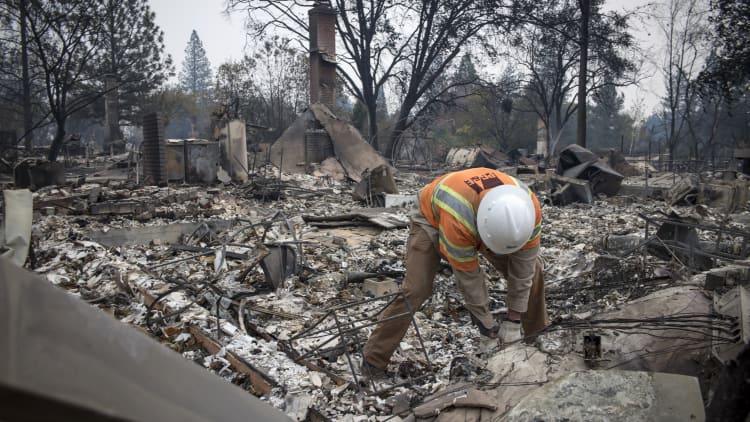
Here's all the ways California's PG&E is trying to fight its massive wildfire problem
California's largest utility company, Pacific Gas & Electric, has been blamed for five of the ten most destructive fires in California since 2015. The deadliest fire in California history killed 85 people in Paradise, California, in 2018 when a live wire broke free from a 99-year-old PG&E electric tower.
Since then, PG&E has been reducing the risk of equipment sparks by shutting off the power in high fire-risk areas during dry, windy weather. It calls these Public Safety Power Shut-Offs, or PSPS events, and in 2019 they left almost a million customers in the dark for seven days.
"Just in those first couple outages, our losses exceeded $30,000," said Brennen Jensen, who couldn't operate the hotel and restaurant she owns in Groveland, California during the outages.
Now, PG&E has partnered with Grass Valley-based startup BoxPower to try out a new solution for keeping the power on safely in remote areas. It's a solar-powered microgrid, housed in a shipping container, that serves as the fulltime power source for five customers in the mountains of Briceburg, California. PG&E is aiming to have 20 standalone remote grids operational by 2022, with plans for several hundred more.
"Within three to five years, you'll be able to look at and say, 'This was not just a one off, but wow, this is a pattern,'" said Jason Glickman, executive vice president of engineering, planning, and strategy at PG&E.
PG&E's $5 billion 2021 Fire Mitigation Plan also includes 300 new weather stations to monitor for severe conditions; LiDAR, drones and hundreds of cameras to provide 90% visual coverage of high fire-threat areas; hardening the system by doing things like moving 23 miles of line near Paradise underground; and more aggressive clearing of trees around power lines.
"It's not an easy job, it's really not. Are they going to protect the community, or are they going to keep people powered up, or are they going to try to maintain the integrity and the aesthetics of the forest?" asked Kevin Kalkowski, who owns a forestry business that comes in and cleans up after PG&E cuts down an increasing number of trees near power lines.
"You can rake every leaf, you can move your woodpile, you can do different things. But there is nothing the homeowner can do about the fact that the wooden pole in your backyard is likely suffering from dry rot and is at risk of collapse," said Catherine Sandoval, who served on the California Public Utilities Commission from 2011 to 2017.
PG&E admitted to regulators in May that it failed to carry out inspections on more than 50,000 poles last year -- 3,000 of which are in extreme fire-risk areas. And it recently disclosed that flawed inspections mean more than half a million aging poles are at risk of dry rot. It's committed to proper inspections by the end of the year.
"We must succeed. Like civilization, California, our communities need all of us to come together to figure out how to solve all these things at once to get clean, reliable, safe, affordable energy. We have to. We are not just going to pack up and leave California," said Bennett Chabot, remote grid program manager for PG&E.
Watch the video to hear from community members and see the five-customer microgrid and other fire mitigation efforts PG&E says are proof it's committed to doing better at keeping the power on and keeping Califronians safe.









